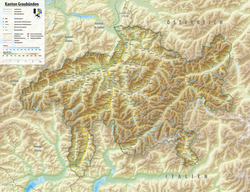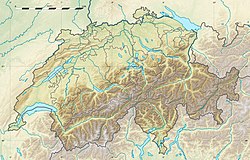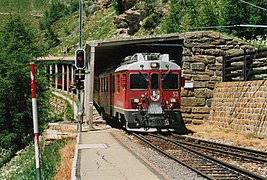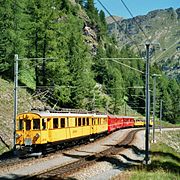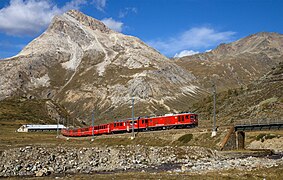Bernina railway line
Graubünden, Switzerland | |
|---|---|
| Part of | Rhaetian Railway in the Albula / Bernina Landscapes |
| Criteria | Cultural: (ii), (iv) |
| Reference | 1276 |
| Inscription | 2008 (32nd Session) |
| Coordinates | 46°24′32″N 10°1′11″E / 46.40889°N 10.01972°E |
The Bernina railway line (
On 7 July 2008, the Bernina line and the
Trains operating on the Bernina line include the Bernina Express.
History
| Bernina railway line | |||||||||||||||||||||||||||||||||||||||||||||||||||||||||||||||||||||||||||||||||||||||||||||||||||||||||||||||||||||||||||||||||||||||||||||||||||||||||||||||||||||||||||||||||||||||||||||||||||||||||||||||||||||||||||||||||||||||||||||||||||||||||||||||||||||||||||||||||||||||||||||||||||||||||||||||||||||||||||||||||||||||||||||||||||||||||||||||||||||||||||||||||||||||||||||||||||||||||||||||||||||||||||||||||||||||||||||||||||||||||||||||||||||||||||||||||||||||||||||||||||||||||||
|---|---|---|---|---|---|---|---|---|---|---|---|---|---|---|---|---|---|---|---|---|---|---|---|---|---|---|---|---|---|---|---|---|---|---|---|---|---|---|---|---|---|---|---|---|---|---|---|---|---|---|---|---|---|---|---|---|---|---|---|---|---|---|---|---|---|---|---|---|---|---|---|---|---|---|---|---|---|---|---|---|---|---|---|---|---|---|---|---|---|---|---|---|---|---|---|---|---|---|---|---|---|---|---|---|---|---|---|---|---|---|---|---|---|---|---|---|---|---|---|---|---|---|---|---|---|---|---|---|---|---|---|---|---|---|---|---|---|---|---|---|---|---|---|---|---|---|---|---|---|---|---|---|---|---|---|---|---|---|---|---|---|---|---|---|---|---|---|---|---|---|---|---|---|---|---|---|---|---|---|---|---|---|---|---|---|---|---|---|---|---|---|---|---|---|---|---|---|---|---|---|---|---|---|---|---|---|---|---|---|---|---|---|---|---|---|---|---|---|---|---|---|---|---|---|---|---|---|---|---|---|---|---|---|---|---|---|---|---|---|---|---|---|---|---|---|---|---|---|---|---|---|---|---|---|---|---|---|---|---|---|---|---|---|---|---|---|---|---|---|---|---|---|---|---|---|---|---|---|---|---|---|---|---|---|---|---|---|---|---|---|---|---|---|---|---|---|---|---|---|---|---|---|---|---|---|---|---|---|---|---|---|---|---|---|---|---|---|---|---|---|---|---|---|---|---|---|---|---|---|---|---|---|---|---|---|---|---|---|---|---|---|---|---|---|---|---|---|---|---|---|---|---|---|---|---|---|---|---|---|---|---|---|---|---|---|---|---|---|---|---|---|---|---|---|---|---|---|---|---|---|---|---|---|---|---|---|---|---|---|---|---|---|---|---|---|---|---|---|---|---|---|---|---|---|---|---|---|---|---|---|---|---|---|---|---|---|---|---|---|---|---|---|---|---|---|---|---|---|---|---|---|---|---|---|---|---|---|---|---|---|---|---|---|---|---|---|---|---|---|---|---|---|---|---|---|---|---|---|---|---|---|---|---|---|---|---|---|---|---|---|---|---|---|---|---|---|---|---|---|---|---|---|---|---|---|---|---|---|---|---|---|
Overhead catenary, 1,000 V DC | |||||||||||||||||||||||||||||||||||||||||||||||||||||||||||||||||||||||||||||||||||||||||||||||||||||||||||||||||||||||||||||||||||||||||||||||||||||||||||||||||||||||||||||||||||||||||||||||||||||||||||||||||||||||||||||||||||||||||||||||||||||||||||||||||||||||||||||||||||||||||||||||||||||||||||||||||||||||||||||||||||||||||||||||||||||||||||||||||||||||||||||||||||||||||||||||||||||||||||||||||||||||||||||||||||||||||||||||||||||||||||||||||||||||||||||||||||||||||||||||||||||||||||
| Highest elevation | 2,253 m (7,392 ft) above sea level | ||||||||||||||||||||||||||||||||||||||||||||||||||||||||||||||||||||||||||||||||||||||||||||||||||||||||||||||||||||||||||||||||||||||||||||||||||||||||||||||||||||||||||||||||||||||||||||||||||||||||||||||||||||||||||||||||||||||||||||||||||||||||||||||||||||||||||||||||||||||||||||||||||||||||||||||||||||||||||||||||||||||||||||||||||||||||||||||||||||||||||||||||||||||||||||||||||||||||||||||||||||||||||||||||||||||||||||||||||||||||||||||||||||||||||||||||||||||||||||||||||||||||||
| Maximum incline | 7% | ||||||||||||||||||||||||||||||||||||||||||||||||||||||||||||||||||||||||||||||||||||||||||||||||||||||||||||||||||||||||||||||||||||||||||||||||||||||||||||||||||||||||||||||||||||||||||||||||||||||||||||||||||||||||||||||||||||||||||||||||||||||||||||||||||||||||||||||||||||||||||||||||||||||||||||||||||||||||||||||||||||||||||||||||||||||||||||||||||||||||||||||||||||||||||||||||||||||||||||||||||||||||||||||||||||||||||||||||||||||||||||||||||||||||||||||||||||||||||||||||||||||||||
| |||||||||||||||||||||||||||||||||||||||||||||||||||||||||||||||||||||||||||||||||||||||||||||||||||||||||||||||||||||||||||||||||||||||||||||||||||||||||||||||||||||||||||||||||||||||||||||||||||||||||||||||||||||||||||||||||||||||||||||||||||||||||||||||||||||||||||||||||||||||||||||||||||||||||||||||||||||||||||||||||||||||||||||||||||||||||||||||||||||||||||||||||||||||||||||||||||||||||||||||||||||||||||||||||||||||||||||||||||||||||||||||||||||||||||||||||||||||||||||||||||||||||||

In the year following the completion of the
The line opened from 1908 onwards, in several sections: on 1 July 1908 between
Originally, the Bernina line was intended for use only in summer, but in 1913/14 the BB commenced winter operations as well. This development was associated with major weather-related problems, necessitating further erection of avalanche barriers.
In the first years of its existence, the BB was always on the verge of bankruptcy. The costs of construction expenditure on the line to 1915 amounted to around 15 million
The RhB modernised the line fundamentally, also for military reasons, and completely renewed the section at the top of the pass. Previously, the line formation on the north ramp of the Bernina Pass had been laid out in curves giving
Since the mid-1980s, the Rhaetian Railway has been marketing the natural and technical attractions of the Bernina line specifically to tourists. Thus, the section from Pontresina to Tirano forms part of the route of the Bernina Express. In October 2011, it was the first railway line in the world to be photographed and put on Google Street View.[3][4][5]
Description of the railway
St Moritz is the terminus of both the

The next station in

The line now turns to the south east. After crossing the Rosegbach, passing through the
The next section is probably the most interesting on the north side of the pass. Here, the route is very winding, and moves from one side of the valley to the other. First, the Berninabach is crossed, using the 37 m (121 ft) long Lower Berninabach Bridge, and then the line crosses the Arlasbach, a tributary of the Berninabach. On the Upper Berninabach Bridge, the line moves back to the eastern side of the valley. Southwest of here, the
.The railway now runs along the eastern bank of the lake, and, near
After the Grüm Gallery, the attractive
Immediately behind the Alp Grüm station, the line winds in a tight 180° bend, and passes below Alp Grüm through the Upper Palü Gallery. In a further 180° bend, it heads through the Palü Tunnel and subsequently through the Lower Palü Gallery. A further four half circle loops follow, until the line reaches the
At the request of the Poschiavo community, the station at Poschiavo was built just outside the village boundaries. It has a railway depot and workshop, in which a few historic railcars of the Bernina line are also stored. The remaining section of line of approximately 17 km (11 mi) to Tirano are laid partially still as a mountain railway, but also partially in the manner of a tramway system. After the stopping point


Below
Rolling stock and traffic
Today, the following classes of railcar and locomotive are used in scheduled commercial services on the Bernina line: fifteen
This fleet, consisting of
The timetable is tightly designed, with year-round services of one
In winter, an old 1913 steam rotary snowplow is regularly in service, but also two electrical rotary snowplows from 1968 and also two modern engines from 2010 are used as well. Their operation is also a tourist attraction that draws in railway enthusiasts from all over the world, especially for the steam one. The two Gem 4/4 assure the shunt of the rotary snowplow.
In connection with the danger of avalanches on the Bernina line, the Rhaetian Railway has developed an unusual procedure for the removal of these high alpine hazards. In late winter, when the risk of avalanche is greatest, artillery is fired at the points of origin of avalanches, to bring some control to their occurrence.
References
Notes
- ISBN 978-3-89494-130-7.
- ^ "Candidature UNESCO World Heritage - Rhaetian Railway in the Albula/Bernina Cultural Landscape" (PDF). Rhaetian Railway. p. 63. Retrieved 28 September 2020.
- ^ "Street View hits the stunning Swiss Alps railways". Google Official Blog. 20 October 2011. Retrieved 2014-04-06.
- ^ "Street View Rhaetian Railway". Rhaetian Railway. Archived from the original on 2014-04-07. Retrieved 2014-04-06.
- ^ "Google Street View on Bernina Railway". Netzwelt (in German). October 19, 2011.
Bibliography
- Caminada, Paul (1980). Der Bau der Rhätischen Bahn. Zürich: Orell Füssli Verlag.
- Caprez, Gion; Pfeiffer, Peter (2000). Die Goldenen Jahre der Berninabahn. Zürich: AS Verlag & Buchkonzept AG. ISBN 3-905111-48-9.
- Moser, Beat; Pfeiffer, Peter (2004). Die RhB. Teil 2: Berninabahn • St. Moritz – Tirano [The RhB. Part 2: Berninabahn • St. Moritz – Tirano]. Eisenbahn Journal Special-Ausgabe 2/2004. Fürstenfeldbruck: Eisenbahn Journal. ISSN 0171-3671.
- "Mit der Rhätischen Bahn von St. Moritz nach Tirano". BahnGalerie. Bernina. 2002.
- Tarnuzzer, Christian (1909). Die Bernina-Bahn. photographs by D. Mischol. Chur und St. Moritz: Ebner & Cie.
- Tognina, Andrea (2010). Arbeiter am Bernina. Sozialgeschichte eines Bahnbaus, 1906–1910. Chur: Desertina.
- Tognina, Andrea (2010). Gli operai del Bernina. Storia sociale di un cantiere ferroviario. Coira: Desertina.
Audio-visual material
- "Von Pontresina, Oberengadin, nach Bernina Hospiz", Welt-Kinematograph, Freiburg i. Br., Germany 1909 or 1910.
- "Mit der Berninabahn", Welt-Kinematograph, Freiburg i. Br., Germany 1910.
- "Le Ferrovie del Bernina", Pasquali e C., Turin, Italy 1911.
- "The Bernina Railway (Switzerland)", Urbanora, Great Britain 1912.
- "La Ferrovia del Bernina", Regie: Giovanni Vitrotti, Società Anonima Ambrosio, Turin, Italy 1913.
- "Europe's Winter Playground", Director: Frederick Burlingham, British & Colonial Kinematograph Company, Great Britain 1913.
- "Dallo Spluga al Bernina", Luca Comerio, Milan, Italy 1914.
- "Eine Fahrt mit der Bernina-Bahn (Schweiz)", Sascha-Filmfabrik, Vienna, Austria 1914.
- The TV program "Die schönsten Bahnstrecken Europas", which was shown on Germany's ARD network (see also Das Erste), included a cab ride on the Bernina line.
Images
-
A Rhaetian Railway train in Tirano.
-
An RhB Regio train to Tirano between Lagalb and Ospizio Bernina.
-
Bernina Express panorama cars in Tirano.
-
Lei Pitschen in winter.
-
Regional train on the Bernina line on the shores of Lake Nero in the Lago Bianco to the Bernina Pass
-
Crossing the upper Berninabach Bridge.
-
Grüm Galery at Alp Grüm.
-
A down valley train at Poschiavo station.
-
Rhaetian Railway station in Tirano.
-
ABe 4/4 I 30 and 34 belowAlp Grüm.
-
Hybrid loco Gem 4 / 4 in service at the head of a Regio train to Tirano.
-
Rotary snowplow Xrotd 9213 with dual-mode Gem 4 / 802 4 in action
-
RhB EMUs ABe 4/4 III 55 "Diavolezza" and 54 "Hakone" cross the "Am See Brücke"

